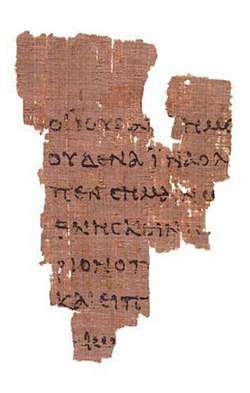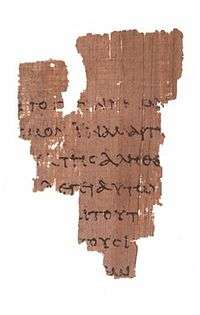John 18
John 18 is the eighteenth chapter of the Gospel of John in the New Testament of the Christian Bible. The book containing this chapter is anonymous, but early Christian tradition uniformly affirmed that John composed this Gospel.[1] This chapter records the events on the day of the crucifixion of Jesus Christ, starting with His arrest.[2]
| John 18 | |
|---|---|
 John 18:31-33 on John Rylands Library Papyrus P52 (recto), written ca. AD 125. | |
| Book | Gospel of John |
| Category | Gospel |
| Christian Bible part | New Testament |
| Order in the Christian part | 4 |
Text
The original text was written in Koine Greek. This chapter is divided into 40 verses.
Textual witnesses
Some early manuscripts containing the text of this chapter are:
- Rylands Library Papyrus P52 (~Anno Domini 125; extant verses 31-33, 37-38)
- Papyrus 90 (A.D. 150-175; extant verses 36-40)
- Papyrus 108 (2nd/3rd century; extant verses 1-5)
- Papyrus 66 (A.D. ~200; complete)
- Codex Vaticanus (A.D. 325-350)
- Codex Sinaiticus (A.D. 330-360)
- Codex Bezae (A.D. ~400)
- Codex Alexandrinus (A.D. 400-440)
- Codex Ephraemi Rescriptus (A.D. ~450; extant verses 1-35)
- Papyrus 60 (A.D. ~700; complete).
- Papyrus 59 (7th century; extant verses 1-2, 16-17, 22).
Places
The events recorded in this chapter took place in Jerusalem.
Jesus' betrayal and arrest in Gethsemane
The opening of chapter 18 is connected directly with the final words of chapter 14:
- Arise, let us go from here (John 14:31).
The intervening chapters record Jesus' Farewell Discourse. Plummer, in the Cambridge Bible for Schools and Colleges (1902), suggests that Jesus and His disciples have "rise[n] from table and prepare[d] to depart at John 14:31, but that the contents of chapters 15-17 are spoken before they leave the room".[3]
Verse 1
- When Jesus had spoken these words, He went out with His disciples over the Brook (or winter stream) Kidron, where there was a garden, which He and His disciples entered.[4]
Some translations instead open with "When He had finished praying" or similar words.[5]
Matthew 26:36 and Mark 14:32 name the garden as "Gethsemane", but it is unnamed here.
Verse 2
Judas is now called "Judas the betrayer" or "Judas, who is betraying" (Greek: ιουδας ο παραδιδους, ioudas ho paradidous) (John 18:2 and again in verse 5).[7] He comes to this familiar place with troops, a captain and officers and servants of the chief priests and the Pharisees, carrying torches and lanterns and weapons (verse 6, cf. verse 12). Anglican bishop Charles Ellicott surmises that Gethsemane might have been belonged to "a friend or disciple" of Jesus.[8] The New American Standard Bible notes that the troops were the Roman cohort (Greek: σπεῖρα, speira in John 18:3 is the technical word for the Roman cohort) [8] whereas Richard Francis Weymouth identified them as a detachment of the Temple police.[9] This was the garrison band from Fort Antonia, at the north-east corner of the Temple. Peter also came with a weapon (verses 10-11):
Verse 4
- Jesus therefore, knowing all things that would come upon Him, went forward and said to them, “Whom are you seeking?”[11]
Plummer notes from this verse that the evangelist's narrative confirms:
- the voluntariness of Christ’s sufferings, and
- the fulfilment of a divine plan in Christ’s sufferings
and that the aim of the narrative is to endorse Jesus' earlier words,
- I lay down My life that I may take it again. No one takes it from Me, but I lay it down of Myself. I have power to lay it down, and I have power to take it again.[12]
and the evangelist's earlier commentary
In the High Priest's Courtyard
Jesus and "another disciple", or "the other disciple",[15] who was known to the high priest, are taken to the High Priest's Courtyard, where initially Jesus meets with Annas. Some scholars identify the anonymous disciple as “the disciple whom Jesus loved.”[16] The other disciple then brings in Peter.[17] Unusually, John Wycliffe's bible translates Greek: τω αρχιερει, tō archierei as "the bishop".[18]
In Pilate's Court

Verse 28
- Then they [the Jewish leaders] led Jesus from Caiaphas to the Praetorium, and it was early morning. But they themselves did not go into the Praetorium, lest they should be defiled, but that they might eat the Passover.[19]
The Jewish leaders: words supplied by the New International Version to clarify "they".[20] The reference is to the Sanhedrists according to Scottish Free Church minister William Nicoll.[21] The text here confirms that in John's timeline, the trial of Jesus took place before the Passover and therefore likewise the events of chapters 13-17 preceded the Passover: cf. John 13:1: before the Feast of the Passover ...
Verse 31
- Then Pilate said to them, "You take Him and judge Him according to your law."
- Therefore the Jews said to him, "It is not lawful for us to put anyone to death,"[22]
Verse 37
- Pilate therefore said to Him, "Are You a king then?"
- Jesus answered, “You say rightly that I am a king.
- For this cause I was born, and for this cause I have come into the world,
- that I should bear witness to the truth.
- Everyone who is of the truth hears My voice.”[23]
Cross reference: Matthew 27:11; Mark 15:2; Luke 23:3
What is truth?
Verse 38
- Pilate said to Him, "What is truth?"
- And when he had said this, he went out again to the Jews,
- and said to them, "I find no fault in Him at all."[24]
See also
- Arrest of Jesus
- Barabbas
- Denial of Peter
- Jerusalem
- Jesus Christ
- Pontius Pilate
- Rylands Library Papyrus P52
- Sanhedrin trial of Jesus
- Other related Bible parts: Matthew 26, Matthew 27, Mark 14, Mark 15, Luke 22, Luke 23, John 13, John 19
References
- Holman Illustrated Bible Handbook. Holman Bible Publishers, Nashville, Tennessee. 2012.
- Halley, Henry H. Halley's Bible Handbook: an Abbreviated Bible Commentary. 23rd edition. Zondervan Publishing House. 1962.
- Plummer, A. (1902), Cambridge Bible for Schools and Colleges on John 14, accessed 5 July 2016
- John 18:1 NKJV
- For examples, New International Version, International Children's Bible and Weymouth New Testament
- John 18:2 NKJV
- Vincent's Word Studies on John 18, accessed 12 July 2016
- Ellicott's Commentary for English Readers on John 18, accessed 16 July 2016
- Weymouth New Testament, John 18:3
- John 18:10 NKJV
- John 18:4 NKJV
- John 10:17-18 NKJV
- John 13:1 NKJV
- Plummer, A. (1902), Cambridge Bible for Schools and Colleges on John 18, accessed 8 June 2019
- The NKJV notes "the other" as an alternative; this is preferred by Darby
- Raymond E. Brown, The Gospel According to John (xiii-xxi)( New York: Doubleday & Co., 1970), 922, 955; James L. Resseguie, “The Beloved Disciple: The Ideal Point of View,” in Character Studies in the Fourth Gospel: Narrative Approaches to Seventy Figures in John, ed. Steven A. Hunt, D. Francois Tolmie and Ruben Zimmermann, Wissenschaftliche Untersuchungen zum Neuen Testament 31 (Tübingen: Mohr Siebeck, 2013), 541-3; reprint (Grand Rapids, MI: Eerdmans, 2016), 547-49.
- John 18:13-16 NKJV
- Noble, T. P. (2001), Wycliffe's Bible: John 18, several verses
- John 18:28 NKJV
- John 18:28 NIV
- Nicoll, W. R. (1897 ff), The Expositor's Greek Testament on John 18, accessed 13 June 2019
- John 18:31 NKJV
- John 18:37 NKJV
- John 18:38 NKJV
External links
- John 18 King James Bible - Wikisource
- English Translation with Parallel Latin Vulgate
- Online Bible at GospelHall.org (ESV, KJV, Darby, American Standard Version, Bible in Basic English)
- Multiple bible versions at Bible Gateway (NKJV, NIV, NRSV etc.)
| Preceded by John 17 |
Chapters of the Bible Gospel of John |
Succeeded by John 19 |